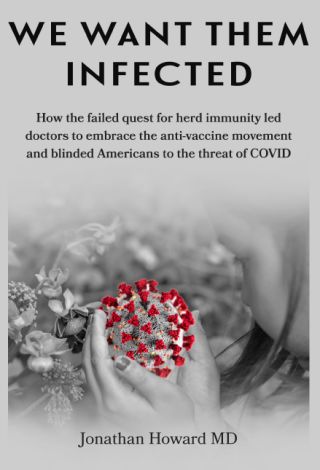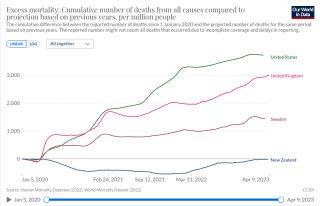Coronavirus Disease 2019
“We Want Them Infected”: A Review of the Push for Herd Immunity
A new book mounts a scathing critique of the U.S. pandemic response.
Updated September 27, 2023 Reviewed by Devon Frye
Key points
- COVID has led to 15 million excess deaths worldwide in two years, reports the World Health Organization.
- The U.S. makes up about 5 percent of the world’s population, but more than 20 percent of global COVID deaths.
- Mass infection was a centerpiece of the pandemic response, months before vaccines were even available.
- A new book explains why, and the harm caused by such an approach.

We Want Them Infected, the bracing title to Jonathan Howard’s just-published book on the U.S. coronavirus response, isn’t an allusion to sci-fi dystopia or fringe conspiracy.
Those four words—and, importantly, the policy they would underwrite—belong to Dr. Paul Alexander, an epidemiologist and official in the U.S. Department of Health and Human Services during the Trump administration. For most of 2020—when, at the worst moments, more than 2,000 Americans were dying of COVID (SARS-CoV-2) each day—they formed a centerpiece of the White House response.
“Infants, kids, teens, young people, young adults, middle-aged with no conditions, etc. have zero to little risk,” Alexander assured on July 4, 2020, more than five months before anyone had been vaccinated and when data did, in fact, show risk. “So we use them to develop herd… we want them infected.”
Before the federal agency he represented could say with certainty when vaccines would be available—before any serious reckoning with the precautionary principle, a bedrock to U.S. public health policy since the 1970s—Alexander advocated openly for the mass infection of infants, children, young adults, and the middle-aged “with no conditions, etc.,” on the assumption that doing so would hasten population immunity without mass sickness or mass death.

As readers of COVID news will already know, and Howard’s book documents with much-needed rigor and tenacity, it did neither. More than 850,000 people have since died from the virus in the U.S. alone.
Alexander, we now learn, was supported by several high-profile epidemiologists, health economists, and even a radiologist whose early, error-strewn talking points—widely publicized by conservative and libertarian think tanks—helped set COVID policy at the federal level.
With their shared emphasis on intentional mass infection of the unvaccinated documented unflinchingly in this book, it is much easier to grasp why, of necessity, that policy came to include vehement opposition to almost all previously accepted public health measures—targeted local lockdowns and social distancing, testing and contact-tracing, masking and indoor air changes, and eventually, cross-generational vaccination.
To the scientists and doctors who, in the first weeks of the pandemic confidently dismissed infectious disease guidelines the Obama administration had left in place, any and all harm reduction merely delayed population-wide immunity. Against a backdrop of mass illness and death, their alternative now includes failed “endemicity,” near-endless waves and variant surges, large numbers of children both sick with and dead from COVID, and higher-than-anticipated reinfection numbers in all age groups. In short, those who supported “let it rip” gave the virus almost unencumbered freedom to transmit.
An Associate Professor of Neurology and Psychiatry at New York University and Chief of Neurology at Bellevue Hospital, Howard is a regular contributor to Science Based Medicine and an expert debunker of medical misinformation and intentional disinformation. As important, he was also an active contributor to New York’s frontline response to COVID's first wave, when up to 800 people citywide died daily of the virus, field hospitals were rapidly assembled, and healthcare workers and frontline responders were nightly cheered for risking infection and death while caring for the gravely ill.
“I saw more people die in a few weeks than I had in my entire career,” he writes, haunted by unshakeable memories of his ICU at the time and by questions of what, if anything, his team might have done differently. In those first weeks of the pandemic, front-line workers had few effective therapeutics against SARS-CoV-2, and prognoses of its evolution—from rate of transmission to eventual reinfections—were often wide of the mark, wrong-footing many.
Nevertheless, as the publication of We Want Them Infected joins WHO announcements that COVID has led to 15 million excess deaths worldwide in two years and a sharp drop in life expectancy across the U.S. and much of the rest of the world, it is crucial to restate Howard’s principal caveat: “No population has ever achieved herd immunity to a virus through natural infection alone.”
When, as I wrote in March 2020, Britain joined the U.S. and Sweden in adopting what its policy-makers believed would be “controlled infection” among the “nonvulnerable,” Suzi Ring and James Paton reported in Bloomberg on the dubious math informing the modeling, and the complete upending of standard precautions about the unknown, SARS-like virus:
"The estimate of 60 percent equates to about 40 million cases in the U.K. and 800,000 deaths, assuming a fatality rate of 2 percent. Herd immunity is usually used in the context of diseases for which there are vaccines, [University of Edinburgh professor of global public health] Devi Sridhar said. So far, there’s none for the new coronavirus."
As Howard extrapolates in one of his book’s many zingers: “The idea that the best way to protect yourself from a virus is to get the virus is like using pregnancy as a form of contraception.”
“Cheerleaders for the Virus”
Why, then, did the earliest advocates for COVID herd immunity not change course, even after successive waves and mass infection had left more than 1.1 million dead in the U.S. alone?
Among Howard’s many incisive revelations: Early advocates for such “herd immunity” (also known as “natural” and “population” immunity) deliberately recycled and repurposed tropes from the AIDS pandemic—for instance, adapting the 1980’s myth that HIV does not cause AIDS. They also, he notes, “spoke about SARS-CoV-2 the exact same way anti-vaxxers speak about measles or HPV.”
Even more strikingly, because they “wanted the virus to spread widely,” the arrival of vaccines “did nothing to dampen their enthusiasm to spread” it. On the contrary, as the rhetoric and case numbers led to gulf-like distances drawing notice and criticism at the time, the “Disinformation Dozen” of COVID contrarians not only doubled down on their falsehoods but claimed that they had been misquoted and misunderstood, then silenced, because of their shared “heterodoxy” in questioning viral strength and lethality.
Even after U.S. deaths from COVID reached 20,000, the preset default of mass infection helped many turn the numbers into abstractions. Just as remarkable, scientists who had made careers in some form of “evidence-based medicine” themselves became, in Howard’s verdict, “impervious to evidence.” Ultimately, even a million excess deaths couldn’t “dent [their] denialism.”
Instead, in likening the virus to the much-less lethal flu and chickenpox and by downplaying the risk of longer-term consequences, such as Long COVID, they made it an article of faith that infection from COVID would build robust and lasting immunity. In Howard’s words, “They falsely pacified millions of Americans about the dangers of COVID… relentlessly minimized the virus for young people, and trashed any and all measures to limit infections in this population.”
“A Consistent Pattern of Minimizing Harms”
Chief among this pattern’s characteristics, Howard identifies:
- An insistent belief that natural immunity would lead to permanent immunity and near-zero reinfections (both claims since thoroughly discredited).
- Mockery of “draconian countermeasures” such as lockdowns, testing, and even “excessive” interest in case numbers; all seen as hostile to, or at the least as delaying, natural immunity. (The adjective “draconian,” recurring in most such examples, becomes a “tell.”)
- A consistently blasé attitude toward sick children, combined with an unwillingness to abandon the belief that unvaccinated children ought to contract COVID, as if it were a duty. (In the UK, to give just one example, a sociologist serving on the government’s Joint Committee on Vaccination and Immunisation spoke of infection’s likely “substantial long-term benefits,” and that school closures may have “an immediate cost in terms of depriving children of the opportunity to acquire immunity to the infection.”)
- “Fear of the virus” frequently asserted as worse than the virus itself. Sometimes, even as a major contributor to excess deaths.
- A belief that COVID’s death toll was inflated and its overall threat to the nonelderly greatly exaggerated.
Infiltrating the White House
Among the biggest surprises in Howard’s book—first reported by Stephanie M. Lee at BuzzFeed on July 24, 2020—is news of an email Stanford epidemiologist John Ioannidis sent his like-minded collaborators on March 28 that year, concerning shared attempts at influencing the Trump White House, and thus federal policy, on herd immunity (Lee reproduces a copy of the email). Though a planned meeting did not go ahead, Ioannidis wrote: “I think our ideas have inflitrated [sic] the White House regardless.”
Indeed they had. In a New York Times article titled “White House Embraces a Declaration from Scientists That Opposes Lockdowns and Relies on ‘Herd Immunity,’” Ioannidis’s colleague Scott Atlas is said by the House Select Subcommittee on the Coronavirus Crisis to have already sent
"... an email to [Centers for Medicare and Medicaid Services Administrator] Seema Verma to advocate against 'the need for lockdown and even the frantic need for urgent testing,' calling the federal government’s approach to combating the virus 'a massive overreaction' that was 'inciting irrational fear' in Americans. Dr. Atlas stated that the early data showed the 'virus would cause about 10,000 deaths'—a number that he claimed 'would be unnoticed' in a normal flu season—and argued that '[t]he panic needs to be stopped.'”

By December 2020, The Washington Post reported, Ioannidis himself “had appeared at least 18 times on major cable news networks, repeatedly questioning the severity of the pandemic.” His colleague Scott Atlas came to President Trump’s attention the exact same way. Once appointed as Special Advisor on COVID to the White House, Atlas, according to then-CDC Director Robert Redfield, “brought… individuals to the White House specifically ‘to convince people that herd immunity was going to save us, and this thing was going to go bye-bye.’”
Conclusion: “Much of This Was Avoidable”
Although such snapshots can barely scratch the surface of Howard’s detailed study, We Want Them Infected is, he reminds, “fundamentally about the obligations doctors have when communicating with the public about a deadly virus … [and] the real-world consequences of doctors’ failure to meet those obligations.”
A gripping, cautionary tale about the dangers of mainstreaming fringe ideas before turning them into federal policy, We Want Them Infected is damning, indispensable, and one-of-a-kind. It is likely to become canonical.
References
Howard, J., MD (April 2023). We Want Them Infected: How the Failed Quest for Herd Immunity Led Doctors to Embrace the Anti-Vaccine Movement and Blinded Americans to the Threat of COVID. Redhawk Publications. [Link]




